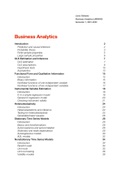Samenvatting
Summary Business Analytics/Econometrics for DS (JBM040/JBM045) 2021/2022
- Instelling
- Technische Universiteit Eindhoven (TUE)
This 40-page summary consists all the information necessary to prepare for the JBM040 Business Analytics (becomes JBM045 Econometrics for DS) exam. The summary includes descriptions of all relevant concepts, formulas and statistical assumptions. Additionally, several proofs are added at the end of ...
[Meer zien]





